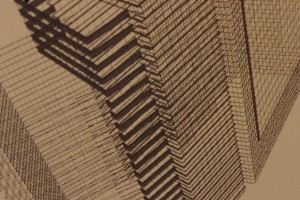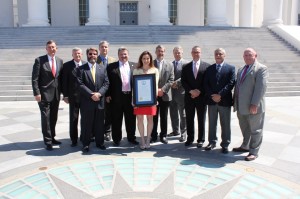
Buildings shape our lives and reveal our history. The year 2014 marks the 100th anniversary of the Virginia Society of the American Institute of Architects. In close collaboration with the Virginia Center for Architecture, the two organizations are embarking on a public outreach program called Virginia Celebrates Architecture. One element of this program is to introduce new conversations about the built world and the part it played in shaping Virginia’s history.
In recognition of Black History Month in Virginia, the Virginia Society AIA and the Virginia Center for Architecture have assembled 10 structures that changed history in the Commonwealth.
1. Robert Russa Moton High School — A student-led strike at this Virginia school played a significant role in ending segregated “separate but equal” schools throughout the nation.
2. Fort Monroe — In 1861,the commander at this Hampton fortification announced that his troops would not enforce the Fugitive Slave Act. Slaves who fled to the fort would be treated as “contraband of war” and not be returned. By the time the Civil War ended in 1865, it is estimated that more than 10,000 enslaved African Americans sought refuge at Fort Monroe. [adrotate banner=”53″]
3. Harrison School — Now the Harrison Museum of African American Culture, the Harrison School was the first public high school for African-American students in Southwest Virginia.
4. Gum Springs — West Ford, a former slave, founded Gum Springs after being freed by George Washington. The oldest African-American community in Fairfax County, Gum Springs became a sanctuary for freedmen and was an important stop on the Underground Railroad.
5. The St. Luke Penny Savings Bank — Conceived of by Maggie L. Walker, St. Luke’s provided a courteous, safe place for African Americans to conduct financial business during a time when Jim Crow laws and oppressive conditions made banking difficult for many blacks.
6. Kate Waller Barrett Branch Library — On August 21, 1939 — more than two decades before the famous sit-in movement — five young African Americans staged what is thought to be the first planned sit-in at the public library in Alexandria, Virginia.
7. Jackson Ward — After the American Civil War, previously free blacks joined freed slaves and their descendants and created this thriving African-American business community, which became known as both the “Black Wall Street of America,” and “The Harlem of the South.”
8. Attucks Theatre — Built in 1919, the Attucks Theatre was designed, developed, financed, and operated entirely by African Americans. Once known as the “Apollo of the South,” the theatre is named in honor of Crispus Attucks, the first American casualty of the Revolutionary War in the 1770 Boston Massacre.
9. Manassas Industrial School —The school was founded largely through the efforts of former slave Jennie Dean who, after years of fundraising, chartered the school on October 7, 1893. The school taught both academic subjects and skilled trades to young African Americans.
10. Longdale Recreation Area/Green Pastures Recreation Area — At the urging of the Clifton Forge Chapter of the NAACP, the Forest Service constructed this recreation area to be used by African Americans in the area. It was built by a local Civilian Conservation Corps company from 1938 to 1940 for the African American community in response to the construction of the whites-only Douthat State Park.
About the Virginia Society of the American Institute of Architects
The Virginia Society of the American Institute of Architects is a professional association representing nearly 2,500 members. Since 1914, the Virginia AIA has represented the professional interests of architects and allied professionals in the Commonwealth of Virginia. For more information, contact the Virginia Society at (804) 644-3041 or visit www.aiava.org.
About the Virginia Center for Architecture
The Virginia Center for Architecture is located at 2501 Monument Avenue in Richmond, Virginia’s historic Fan District. The Center is dedicated to developing the understanding of the power and importance of architecture through programs, exhibitions, and its stewardship of an historic landmark. The Center is open to the public Tuesday through Friday from 10 a.m. to 5 p.m.; Saturday and Sunday from 1 to 5 p.m. Learn more at www.architectureva.org.
About Virginia Celebrates Architecture
Virginia Celebrates Architecture is a year-long public outreach program marking the 100th anniversary of the American Institute of Architects in Virginia. It is intended to develop a broader understanding of architecture and design by beginning new conversations about buildings and the impact they have on our lives. Learn more at www.vacelebrates.org.




